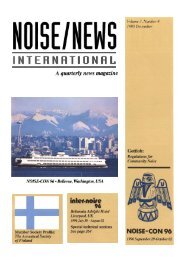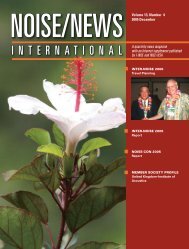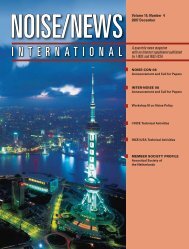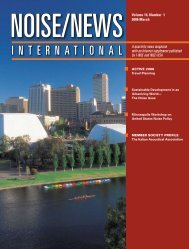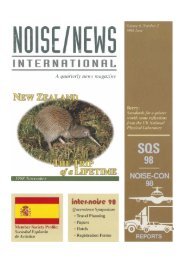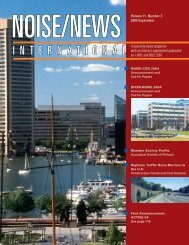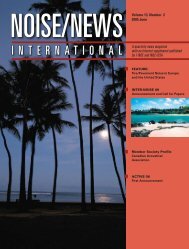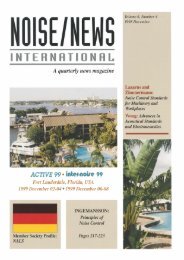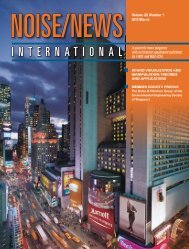Volume 4, Number 1, March, 1996 - Noise News International
Volume 4, Number 1, March, 1996 - Noise News International
Volume 4, Number 1, March, 1996 - Noise News International
- No tags were found...
Create successful ePaper yourself
Turn your PDF publications into a flip-book with our unique Google optimized e-Paper software.
the United States of America (INCE/USA) wasestablished in 1971 June as a professional societysensitive to the needs and responsibilities of noisecontrol engineers and dedicated to a leadership rolein applying noise control technology to the benefitof mankind.Interest in international affairs has always been akey concern of INCEIUSA. Section 5 of its ArticlesofIncorporation states: "As interest in noise controlengineering develops in other parts of the world, theInstitute shall encourage and participate in the establishmentof national institutes in other countriesleading to an eventual federation of institutes ofnoise control engineering." INCEIUSA played amajor role in the establishment in 1974 October ofthe <strong>International</strong> Institute of <strong>Noise</strong> Control Engineering(I-INCE). With the formation of <strong>International</strong>INCE, responsibility for organizing theINTER-NOISE series of international congresseswas transferred by the Board of Directors ofINCEIUSA to the new organization.In those years that an INTER-NOISE Congressis held outside the USA, INCEIUSA sponsors anational conference on noise control engineering.The first NOISE-CON was held in Washington,D.C., in 1973 October. Thirteen NOISE-CONs havebeen held to date. The next one is scheduled for theend of <strong>1996</strong> September, in Bellevue, Washington,USA. The papers presented at a NOISE-CON coverall aspects of noise control engineering.INCEIUSA currently has almost 1200 membersand associates. <strong>Noise</strong> Control Engineering Journal(NCE]) is published bimonthly with articles coveringall aspects of noise control engineering. Theother periodical of INCEfUSA is this news magazinewhich is published jointly with <strong>International</strong>INCE. The first issue of the newsletter <strong>Noise</strong>/<strong>News</strong>appeared in 1972 January. In 1993 <strong>March</strong>, the firstissue of this news magazine was published as aconsolidation of <strong>Noise</strong>/<strong>News</strong> and the I-INCE <strong>News</strong>letter.Production of this news magazine is coordinatedby the Institute of Electrical and ElectronicsEngineers (IEEE).From the Institute's inception, its members haveworked to create an organization dedicated to maintaininga high level of professionalism in its specializedfield through certification of engineeringcompetence, through its popularization of the latestadvances in language accessible by the general public,and through its conferences and publications.The Large Engineering SocietiesThe members of these organizations, who mayormay not identify themselves as acousticians or noisecontrol engineers, are primarily engineers in one ofthe "classical" disciplines (i.e., mechanical, electri-cal, civil, etc.) with interests in acoustics and noisecontrol.The first of the large engineering societies toform its own specialty group in a sub-field of acousticswas the Institute of Radio Engineers (IRE), anorganization which merged with the American Instituteof Electrical Engineers (AlEE) in 1963, and isnow known as the Institute ofElectrical and ElectronicsEngineers (IEEE). The IRE had a numberof professional groups covering various aspects ofradio engineering. The first group to be formed (in1949) was the Professional Group on Audio (PGA)which advertised itself as a "group of members ofthe IRE devoted to the advancement of audio technology."Audiophiles without academic training hadno more interest in joining the IRE than they had injoining the Acoustical Society of America. Hence,the Audio Engineering Society flourished immediatelyafter its founding in 1951, while growth of thePGA was modest. By the time of the merger of theIRE with the AlEE, the PGA was almost defunct.What saved it was a forced consolidation with theIRE's standards committee on audio and electroacoustics.The surviving name, IEEE Group on Audioand Electroacoustics (G-AE), reflected the increasingimportance of electroacoustic transducers inaudio and high fidelity sound reproduction. But bythe middle of the decade of the 1960s, it was clearto the G-AE Administrative Committee that somethingwould have to be done to rejuvenate the groupor it would die.In 1965, Cooley and Tukey published a paper inMathematics ofComputation on their rediscovery ofthe Fast Fourier Transform (FFT). There were thoseon the G-AE Administrative Committee who saw abright future for audio and electroacoustics with theadvent of the FFT. In 1966, the G-AE cosponsoreda special workshop (with standing room only) at thespring meeting of the Acoustical Society of Americain Boston which was entitled: Uses ofPower SpectrumAnalysis. The papers presented at this workshopwere published in the first special issue of theIEEE Transactions on Audio and Electroacousticsin 1967. The following year (1968), the G-AE sponsoredthe first of four Arden House Workshops onthe FFT and digital signal processing.In 1970, the IEEE Board instituted a reorganizationof IEEE technical activities. Semi-autonomoussocieties were created within the IEEE structurefrom the existing groups. By the end of 1975, whathad been the IEEE Group on Audio and Electroacousticshad been transformed into the IEEE Societyon Acoustics, Speech and Signal Processing. The eraof explosive growth began. The final step in thetransformation was completed in 1990 when acousticsand speech were dropped from its name. With10<strong>Noise</strong>/<strong>News</strong> <strong>International</strong><strong>1996</strong> <strong>March</strong>



